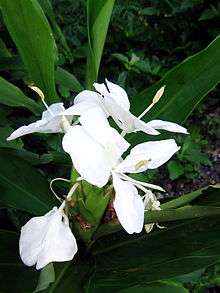Hedychium coronarium
| Hedychium coronarium | |
|---|---|
 | |
| Scientific classification | |
| Kingdom: | Plantae |
| Clade: | Angiosperms |
| Clade: | Monocots |
| Clade: | Commelinids |
| Order: | Zingiberales |
| Family: | Zingiberaceae |
| Genus: | Hedychium |
| Species: | H. coronarium |
| Binomial name | |
| Hedychium coronarium | |
| Synonyms[1] | |
| |
Hedychium coronarium (white garland-lily[2] or white ginger lily[3]) is a perennial flowering plant in the Zingiberaceae (ginger) family native to the Eastern Himalayas region of India (Sikkim), Nepal and Bhutan through northernmost Myanmar and Thailand, southern China (Yunnan, Sichuan, Hunan, Guangxi and Guangdong) to Taiwan in the East.[4][3] It is typically found growing in the forest understory where the pseudostems may reach 1-3m in height arising from below ground rhizomes and in its native environment flowering occurs between August and December.[4]
Cultivation
It is commonly cultivated in warm temperate and subtropical regions of the world as an ornamental and cultivated in China for use in medicine and production of aromatic oil due to its strong characteristic fragrance of the flowers said to be reminiscent of jasmine.[4][5] It is a perennial-green, growing in warmer climates but may also be grown in mild winter temperate regions of North America and Europe where it dies back in winter but re-emerges in spring.[5]
National flower
H. coronarium is the national flower of Cuba, where it is known as mariposa (literally "butterfly") due to its shape. Women used to adorn themselves with these fragrant flowers in Spanish colonial times; because of the intricate structure of the inflorescence, women hid and carried secret messages important to the independence cause under it.[6] The plant has become wild in the cool rainy mountains in Sierra del Rosario, Pinar del Rio Province in the west, Escambray Mountains in the center of the island, and in Sierra Maestra in the very west of it.
Invasive species
Beyond its native range H. coronarium may be invasive in shallow water systems, along streams and in waterlogged areas where once established, it is difficult to control due to vegetative reproduction through underground spread of rhizomes.[5] It was introduced in Brazil in the era of slavery, said to be brought to the country by African slaves who used its leaves as mattresses and is now considered naturalised in the states of Rio de Janeiro (where it is classed as invasive), Bahia and Espirito Santo.[5][7] This species was first introduced as an ornamental to Hawaii around 1888 by Chinese immigrants and is now considered a serious invader in mesic to wet areas of Maui and Hawaii island.[8] It is also invasive in South Africa where it is a declared weed and propagation of plant material is considered prohibited.[9]
 Hedychium coronarium infloresence
Hedychium coronarium infloresence_3.jpg) Hedychium coronarium inflorescence and habit
Hedychium coronarium inflorescence and habit- Hedychium inflorescence and foliage
_(7943791930).jpg) Hedychium coronarium botanical illustration (Curtis.)
Hedychium coronarium botanical illustration (Curtis.)
References
| Wikispecies has information related to Hedychium coronarium |
- 1 2 "Hedychium coronarium". World Checklist of Selected Plant Families (WCSP). Royal Botanic Gardens, Kew. Retrieved 6 January 2017.
- ↑ "Hedychium coronarium". Natural Resources Conservation Service PLANTS Database. USDA. Retrieved 6 January 2017.
- 1 2 "Hedychium coronarium". Germplasm Resources Information Network (GRIN). Agricultural Research Service (ARS), United States Department of Agriculture (USDA). Retrieved 6 January 2017.
- 1 2 3 "Hedychium coronarium in Flora of China @ efloras.org". www.efloras.org. Retrieved 2017-02-15.
- 1 2 3 4 "Hedychium coronarium (white butterfly ginger lily)". www.cabi.org. Retrieved 2017-02-15.
- ↑ "National Flower". Ministry of Foreign Affairs of the Republic of Cuba. Retrieved 6 January 2017.
- ↑ "Floral biology of Hedychium coronarium Koen. (Zingiberaceae)". 2007-01-01. ISSN 1414-039X.
- ↑ "Impact of Alien Plants on Hawai'i's Native Biota". 1998-01-01.
- ↑ "Ornamental plants as Invasive Aliens: Problems and Solutions in Kruger National Park, South Africa". 2008-01-01.
External links
- Flowers of India photos gallery: Ginger Lily (Hedychium coronarium)
- Plant of the Week: Hedychium coronarium
| Wikimedia Commons has media related to Hedychium coronarium. |